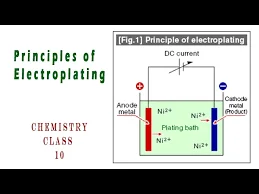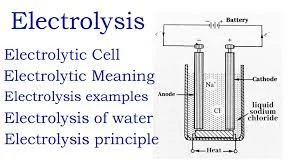Welcome to the world of electroplating and electrolysis, where science meets creativity! Have you ever wondered how those shiny gold or silver coatings magically appear on everyday objects like jewelry, car parts, or even kitchen utensils?
In this blog post, we will unravel the mysteries of electroplating and electrolysis. We'll explore how these techniques work, their applications in various industries, and why they play a crucial role in our modern world.
But first things first: what exactly is electroplating? Let's find out!
What is Electroplating?
Electroplating, in its simplest terms, is a process that involves depositing a thin layer of metal onto the surface of an object. This technique has been around for centuries and is widely used today in various industries such as automotive, electronics, and jewelry making.
At the heart of electroplating lies the concept of electrolysis. During this process, an electric current passes through a solution called an electrolyte containing ions of the desired metal. The object to be plated acts as the cathode (negative electrode), while a metal electrode serves as the anode (positive electrode).
As electricity flows through the electrolyte, it causes chemical reactions to occur. Metal cations from the electrolyte are attracted to and deposited onto the cathode's surface, forming a uniform coating. The thickness and quality of this coating can be controlled by adjusting factors like voltage, temperature, and plating time.
One key advantage of electroplating is its ability to enhance both aesthetics and functionality. With just a simple dip or immersion into specific solutions, objects can be transformed with luxurious gold or silver finishes that not only look stunning but also provide added durability and corrosion resistance.
In addition to decorative purposes, electroplating serves practical applications too. It allows for selective plating on intricate designs or complex shapes that would otherwise be difficult to achieve using traditional methods. Moreover, it aids in preventing oxidation on certain metals like iron or steel by providing them with protective coatings.
Now that you have a basic understanding of what electroplating entails let's explore further into its underlying principles!

The Principles of Electroplating
Electroplating is a fascinating process that involves depositing a thin layer of metal onto an object to enhance its appearance, protect it from corrosion, or improve its conductivity. Understanding the principles behind electroplating can help us appreciate this technique even more.
At its core, electroplating relies on two key principles: electrolysis and electrodeposition. Electrolysis involves passing an electric current through an electrolyte solution containing metal ions. This causes the positively charged metal ions to move towards the negatively charged object, where they are reduced and deposited as a thin layer of metal.
The process of electrodeposition in electroplating occurs due to the different reduction potentials of metals. When two dissimilar metals are connected in an electrolyte solution, one acts as the cathode (where reduction occurs) while the other serves as the anode (where oxidation takes place). The desired metal gets deposited on the cathode surface through this principle.
Various factors influence how well electroplating works, such as temperature, current density, composition and pH level of the electrolyte solution. By controlling these variables precisely, manufacturers can achieve high-quality platings with consistent results.
In modern times, there are several techniques used for electroplating depending on specific requirements and applications. These include rack plating (for large objects), barrel plating (for small parts), brush plating (for localized areas), and continuous reel-to-reel plating (for long strips).
Understanding these fundamental principles allows us to appreciate not only how electroplated products are made but also their many practical applications across industries such as jewelry-making, automotive manufacturing, electronics production,and even aerospace engineering! Electroplated finishes provide durability,dimensional accuracy,and aesthetic appeal that make them indispensable in our daily lives.
The Principles of Electrolysis
Electrolysis is a process that involves the use of an electric current to drive a chemical reaction. It is based on the principles of electrochemistry and plays a crucial role in various industries and applications.
At its core, electrolysis occurs when an electric current passes through an electrolyte solution or molten salt, causing ions to move towards oppositely charged electrodes. The positive ions migrate towards the negative electrode (cathode), while the negative ions are attracted to the positive electrode (anode).
During this migration, chemical reactions take place at each electrode. At the cathode, reduction occurs as positively charged metal cations gain electrons and form solid metal deposits on the surface. Conversely, at the anode, oxidation takes place as negatively charged ions lose electrons and dissolve into their constituent elements or compounds.
The fundamental principle behind electrolysis is Faraday's laws of electrolysis. These laws state that the amount of material produced or consumed during electrolysis is directly proportional to both the current passing through it and its charge.
Electrolysis has numerous practical applications ranging from electrorefining metals like gold and copper to electroplating objects with a thin layer of another metal for protection or aesthetics. Additionally, it plays a vital role in water splitting for hydrogen production and fuel cells.
Understanding the principles of electrolysis enables scientists and engineers to harness this process for diverse purposes across various industries, making it essential knowledge in fields such as materials science, chemistry, engineering, and environmental science.

Types of Electroplating Techniques
Electroplating is a versatile process that allows for the deposition of a wide range of metals and alloys onto various substrates. There are several different techniques used in electroplating, each with its own unique advantages and applications.
One common technique is called barrel plating. As the name suggests, this method involves placing the substrate, along with metal components and abrasive media, into a rotating barrel filled with plating solution. The rotation helps to ensure uniform coverage on all surfaces, making it ideal for small parts or high-volume production.
Another popular technique is rack plating. In this method, individual pieces are mounted on racks and immersed in the plating solution. Rack plating offers more control over the process since each piece can be positioned individually. This makes it suitable for large or irregularly shaped objects that require precise coating thicknesses.
For intricate designs or delicate items, brush plating may be used. With this technique, a small handheld applicator delivers controlled amounts of plating solution directly onto specific areas. It's commonly employed for repairs or touch-ups on already plated items.
In addition to these methods, there are also specialized techniques like pulse-plating and electroless plating which have their own distinct advantages depending on the application requirements.
Understanding these different types of electroplating techniques can help determine which one is best suited for a specific project. Each method has its unique strengths and limitations, and the choice will depend on factors such as the size and shape of the object, desired plating thickness, and overall production requirements.
Applications of Electroplating
Electroplating finds a wide range of applications in various industries, making it an essential process with numerous uses. One of the most common applications is in the automotive industry, where electroplating is used to enhance the appearance and durability of vehicle components. Chrome plating, for example, adds a shiny and corrosion-resistant layer to parts like bumpers and wheels.
In the electronics industry, electroplating plays a crucial role in producing printed circuit boards (PCBs). It helps create conductive pathways on PCBs by depositing metal layers onto them. This ensures efficient electrical connections between different components in electronic devices.
Furthermore, electroplating is extensively used in the manufacturing of jewelry. Gold or silver plating can be applied to base metals like copper or brass to give them an elegant and luxurious finish at a more affordable cost than using solid precious metals.
The aerospace industry also benefits from electroplating techniques. Coatings such as nickel plating are applied to aircraft components to prevent corrosion and improve their resistance against wear and tear.
Moreover, electroplated coatings are utilized for decorative purposes in home appliances, plumbing fixtures, and even furniture hardware. These coatings not only add aesthetic value but also provide protection against rusting or tarnishing over time.
The diverse applications of electroplating highlight its significance across multiple sectors – from automotive and electronics to jewelry-making and aerospace manufacturing. Its ability to enhance appearance, improve durability, protect against corrosion make it indispensable for countless products we use every day.

Conclusion
In this article, we have explored the fascinating world of electroplating and electrolysis. We have learned that electroplating is a process used to deposit a layer of metal onto a surface, while electrolysis involves the use of an electric current to drive a chemical reaction.
The principles behind both electroplating and electrolysis are rooted in the laws of physics and chemistry. Through careful control of variables such as voltage, temperature, and bath composition, manufacturers can achieve precise results when plating or removing metals from various materials.
As we continue to explore new frontiers in science and engineering, it's exciting to contemplate how electroplating and electrolysis will evolve further in the future. Whether it's developing novel materials or finding greener ways to plate metals onto surfaces – one thing remains certain: these principles will undoubtedly continue shaping our world for years to come.
Timonic (Suzhou) Technology Co., Ltd ( Timonic ), a subsidiary of China Special Metal Group Limited (CSM), we commit to the development and production of new energy lithium battery material production equipment: lithium battery copper foil foil machine, cathode roll, especially focusing on providing one-station for high-quality lithium battery copper foil plant design scheme, mechanical and electrical intelligent equipment, software and hardware systems and automation equipment customization and complete sets and technical services.
Welcome to contact us,if you need.
Email:Sales@special-metal.com


